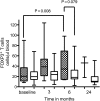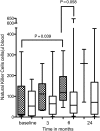Conversion to sirolimus in kidney transplant recipients with squamous cell cancer and changes in immune phenotype
- PMID: 23223314
- PMCID: PMC3572772
- DOI: 10.1093/ndt/gfs474
Conversion to sirolimus in kidney transplant recipients with squamous cell cancer and changes in immune phenotype
Abstract
Background: Conversion to sirolimus from calcineurin inhibitor- (CNI), azathioprine- (AZA) and mycophenolate-based regimens reduces the risk of development of squamous cell carcinoma of the skin (SCC) in kidney transplant recipients (KTRs). Sirolimus conversion may also be protective by permitting beneficial changes in immune phenotype. It is not known how sirolimus will affect immune phenotype in KTRs with SCC.
Methods: Thirty-two KTRs with SCC were enrolled into this single-blinded randomized study and 13 KTRs randomized to sirolimus (4-10 ng/mL) and prednisolone 5 mg/day.
Results: Six-month post conversion to sirolimus FOXP3(+) CD127(low)CD25(high)CD69(-), the number of T cells (putative Treg) increased significantly (P = 0.008). Natural killer (NK) and CD56(bright) NK cells also increased significantly (P = 0.039 and 0.02). T-cell number only significantly increased in those KTRs where CNI was ceased as part of the conversion to mammalian target of rapamycin inhibitors (mTORi's) (P = 0.031) implying CNI cessation rather than mTORi initiation induced an increase in T-cell number. Increases in the NK cell number was only significant in those KTRs where AZA was ceased (P = 0.040), implying AZA cessation rather than mTORi initiation caused the NK cell number to increase. At 6 months, sirolimus conversion reduces new SCC/year, rate ratio 0.49 (95%CI: 0.15-1.63), P = 0.276. On therapy analysis and intention-to-treat analysis over 24 months, the rate ratios were 0.84 and 0.87, respectively, and did not reach significance.
Conclusions: Conversion to mTORi from CNI may reveal a pre-existing high Treg phenotype by unmasking CNI inhibition of FOXP3 expression. Cessation of AZA leads to increased NK cell number. High FOXP3(+) T-cell number on conversion to mTORi may predict those KTRs who continue to accrue SCC.
Figures




Similar articles
-
Effector Antitumor and Regulatory T Cell Responses Influence the Development of Nonmelanoma Skin Cancer in Kidney Transplant Patients.Transplantation. 2017 Sep;101(9):2102-2110. doi: 10.1097/TP.0000000000001759. Transplantation. 2017. PMID: 28403126
-
Conversion From Calcineurin Inhibitors to Mammalian Target of Rapamycin Inhibitors in Kidney Transplant Recipients: A Systematic Review and Meta-Analysis of Randomized Controlled Trials.Front Immunol. 2021 Sep 3;12:663602. doi: 10.3389/fimmu.2021.663602. eCollection 2021. Front Immunol. 2021. PMID: 34539621 Free PMC article.
-
Conversion from calcineurin inhibitors to sirolimus of recipients with chronic kidney graft disease grade III for a period 2003-2011.Vojnosanit Pregl. 2013 Sep;70(9):848-53. doi: 10.2298/vsp1309848i. Vojnosanit Pregl. 2013. PMID: 24266313
-
Proteinuria following conversion from azathioprine to sirolimus in renal transplant recipients.Kidney Int. 2006 Oct;70(7):1355-7. doi: 10.1038/sj.ki.5001792. Epub 2006 Aug 16. Kidney Int. 2006. PMID: 16912706 Clinical Trial.
-
Conversion From Calcineurin to Mammalian Target of Rapamycin Inhibitors in Liver Transplantation: A Meta-Analysis of Randomized Controlled Trials.Transplantation. 2016 Mar;100(3):621-9. doi: 10.1097/TP.0000000000001006. Transplantation. 2016. PMID: 26636736 Review.
Cited by
-
Sirolimus Increases T-Cell Abundance in the Sun Exposed Skin of Kidney Transplant Recipients.Transplant Direct. 2017 Jun 6;3(7):e171. doi: 10.1097/TXD.0000000000000694. eCollection 2017 Jul. Transplant Direct. 2017. PMID: 28706974 Free PMC article.
-
Immune profiling and cancer post transplantation.World J Nephrol. 2015 Feb 6;4(1):41-56. doi: 10.5527/wjn.v4.i1.41. World J Nephrol. 2015. PMID: 25664246 Free PMC article. Review.
-
Management Strategies for Posttransplant Diabetes Mellitus after Heart Transplantation: A Review.J Transplant. 2018 Jan 29;2018:1025893. doi: 10.1155/2018/1025893. eCollection 2018. J Transplant. 2018. PMID: 29623219 Free PMC article. Review.
-
CD4+CD25+ T regulatory cells in renal transplantation.Front Immunol. 2022 Nov 8;13:1017683. doi: 10.3389/fimmu.2022.1017683. eCollection 2022. Front Immunol. 2022. PMID: 36426347 Free PMC article. Review.
-
Impact of immunosuppressants on tumor pulmonary metastasis: new insight into transplantation for hepatocellular carcinoma.Cancer Biol Med. 2024 Dec 24;21(11):1033-49. doi: 10.20892/j.issn.2095-3941.2024.0267. Cancer Biol Med. 2024. PMID: 39718153 Free PMC article. Review.
References
-
- Mathew T, Kreis H, Friend P. Two-year incidence of malignancy in sirolimus-treated renal transplant recipients: results from five multicenter studies. Clin Transplant. 2004;18:446–449. - PubMed
-
- Campistol JM, Eris J, Oberbauer R, et al. Sirolimus therapy after early cyclosporine withdrawal reduces the risk for cancer in adult renal transplantation. J Am Soc Nephrol. 2006;17:581–589. - PubMed
-
- Alberu J, Pascoe MD, Campistol JM, et al. Lower malignancy rates in renal allograft recipients converted to sirolimus-based, calcineurin inhibitor-free immunotherapy: 24-month results from the CONVERT trial. Transplantation. 2011;92:303–310. - PubMed
-
- Guba M, Graeb C, Jauch K-W, et al. Pro- and anti-cancer effects of immunosuppressive agents used in organ transplantation. Transplantation. 2004;77:1777–1782. - PubMed
-
- Guba M, von Breitenbuch P, Steinbauer M, et al. Rapamycin inhibits primary and metastatic tumor growth by antiangiogenesis: involvement of vascular endothelial growth factor. Nat Med. 2002;8:128–135. - PubMed
Publication types
MeSH terms
Substances
Grants and funding
LinkOut - more resources
Full Text Sources
Other Literature Sources
Medical
Research Materials

